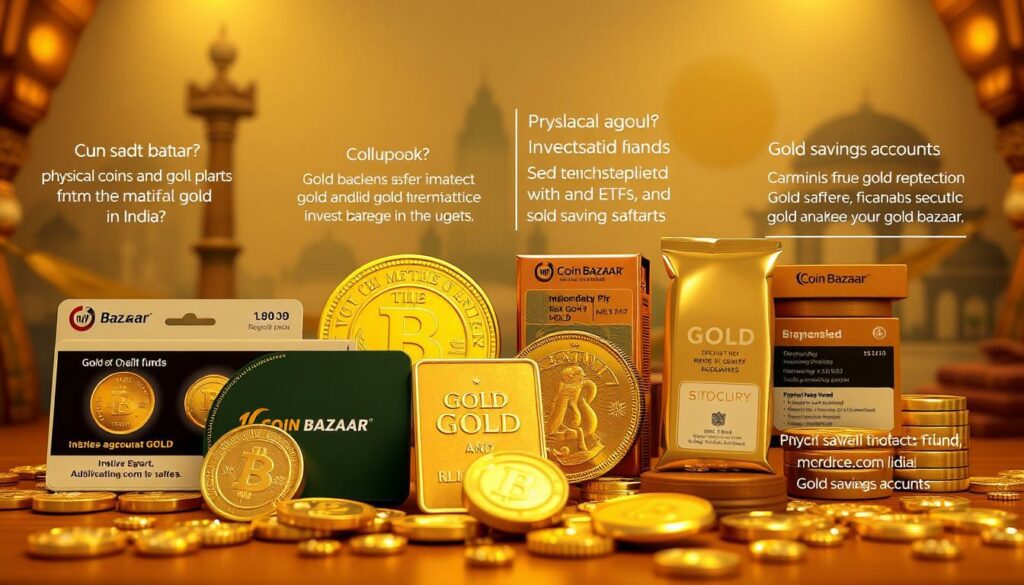Exclusive Deals & Trending Items
Gold is deeply rooted in Indian culture and is a key part of financial planning for many families. However, the rising cost of gold makes big purchases hard. Gold savings schemes offer a solution by allowing you to invest in gold with small, flexible contributions. They help you build your gold portfolio gradually, making big dreams achievable in small steps.
Plans like Jos Alukkas’ Easy Buy Plan offer a 90% discount on one month’s payment. Tanishq’s Golden Harvest gives 75% savings. Banks like the Sovereign Gold Bond Scheme add tax benefits. Brands like Malabar Gold promise lifetime maintenance. But, these options raise questions: How do these plans work? Are the discounts taxable? What risks might you face?
Key Takeaways
- Popular schemes like Tanishq’s Golden Harvest and Malabar’s Smart Buy offer discounts and insurance perks.
- Banks provide options like Gold Monetisation with 0.25-2.5% annual interest on deposited gold.
- Discounts over Rs 50,000 may trigger tax under Section 56(2)(x) of the Income Tax Act.
- Sovereign Gold Bonds offer 2.5% fixed returns without physical gold ownership.
- Experts like Prakash Hegde caution about potential tax implications of “free” scheme benefits.
Understanding Gold Savings Schemes in India
Exploring ways to grow your wealth, gold savings options offer a unique path. These plans let you save small amounts regularly. You can eventually buy physical gold, blending discipline with flexibility.
What Exactly Are Gold Savings Schemes?
Imagine putting aside a fixed amount each month toward buying gold. That’s the core of these gold investment scheme plans. Unlike bank deposits, your contributions directly fund future gold purchases.
For instance, CaratLane’s Plan of Purchase adds a month’s contribution as a bonus. No interest accrues, but you gain tangible gold at the end of your chosen tenure—typically 10 to 24 months.


How These Schemes Have Evolved in the Indian Market
Once basic layaway plans, today’s schemes are smarter. They now include tax benefits, flexible redemption choices, and even government-backed options like Sovereign Gold Bonds (SGBs). These bonds, offering 2.5% annual interest, show how schemes now blend tradition with modern finance.
Digital platforms now let you track progress online, while tax exemptions on income and capital gains make them more appealing.
“Gold savings plans turn small savings into meaningful investments,” says a 2023 RBI report, noting their role in democratizing wealth building.
Key Players Offering Gold Savings Options
Leading the way are jewelers like Tanishq and Malabar Gold, which combine savings with jewelry access. Banks now offer gold-linked accounts, while digital platforms like Zebi simplify buying/sell processes. Even the government promotes SGBs through the RBI, ensuring diverse gold investment scheme choices for all preferences.
With options ranging from physical gold to ETFs, every investor can find a fit for their goals. Research providers, compare terms, and pick a plan that aligns with your timeline and budget.
The Cultural Significance of Gold Investment in India
Gold is more than just a metal in India. It’s a part of everyday life. Families see gold as a sign of wealth, heritage, and safety. During festivals like Diwali or weddings, giving gold jewelry is a tradition that strengthens family ties.


- Weddings often include gold exchanges as part of dowry customs.
- Rituals like Akshaya Tritiya and Dhanteras see spikes in gold purchases.
- Even newborns receive gold coins or jewelry as symbols of blessings.
Today, gold savings schemes reflect these traditions. Services like Paytm’s digital gold make it easy to invest in gold regularly. This way, families can keep up with cultural practices without spending a lot upfront. The Reserve Bank of India’s Revamped Gold Monetisation Scheme (R-GMS) also honors this legacy. It lets families turn old jewelry into cash while keeping its sentimental value.
“Gold is the ultimate wealth preserver,” says a 2023 RBI report, noting India’s 846 tons of central bank reserves. “It’s a cultural anchor and an economic tool.”
Even with changing markets, 94% of households still prefer physical gold. Yet, schemes like R GMS try to mix tradition with new financial ideas. They help families keep their cherished practices while using secure gold investment tools.
For many, gold is a connection between the past and present. It’s a way to hold onto heritage that modern gold savings schemes now make affordable.
Types of Gold Savings Schemes Available to Indian Investors
India has many gold savings plans for different goals. You can choose from physical gold, digital access, or government-backed securities. Here’s how to find the best gold savings plans for you.
Jeweler-Based Plans let you save a little each month. For example, Tanishq’s Golden Harvest gives up to 75% off on jewelry at maturity. Bhima’s Gold Tree Plan offers bonuses after 6 months, and CaratLane’s 10-month plan adds flexibility.
These plans need regular deposits and reward loyal customers with discounts or bonuses.
Bank Gold Savings Accounts offer great options. ICICI’s Dream Gold Plan lets you buy gold coins at 30% off after maturity. The RBI-backed Sovereign Gold Bonds (SGB) pay 2.5% annual interest over 8 years, with exit options from the 5th year.
These gold savings account schemes are perfect for disciplined savers. They offer tax benefits and loan facilities up to 75% of the gold’s value.
- Digital Platforms: Apps like KrazyBee and Myntra Gold let you buy fractions of a gram, starting at just ₹500. These platforms track live gold rates and offer instant redemption.
- Bank Schemes: SBI’s Gold Coins program offers assured purity from 2–50 grams, while ICICI’s Gold Monetization allows interest on deposited gold for 3–15 years.
Each scheme has its own time frame, from 6 months to 5 years. Compare minimum deposits (₹300–₹3,000/month), tax implications, and redemption choices to find the right one. Whether you want jewelry discounts, liquidity, or long-term growth, these options help you save smartly without big upfront costs.
How Gold Savings Schemes Actually Work
Investing in gold through structured plans makes saving easy. Let’s explore the steps from start to finish. We’ll use real examples to show how these gold savings options work.
Payment Structures and Contribution Models
Most plans let you start small. For instance, CaratLane’s Plan of Purchase requires 10 monthly payments. If you pay Rs. 6,000 each month, you’ll pay a total of Rs. 60,000.
But, the 10th payment gets a 90% discount! You only pay Rs. 600 extra, saving Rs. 5,400. This shows how discounts can save you money. Other plans, like Tanishq’s Golden Harvest, offer a 75% discount on one installment after 12 months.
Malabar Gold’s Golden Gain requires 11 monthly payments. You won’t pay extra charges when you buy jewelry at the end.
Maturity and Redemption Processes
At maturity, you can choose to get physical gold, take cash, or roll over funds. GRT’s Golden Eleven Flexi Plan lets you buy jewelry without extra charges after 11 payments. Jos Alukkas’ Easy Buy plan offers a 90% discount on the final installment.
Always check the terms: Some schemes require full payments before you can redeem your gold.
Physical Gold vs. Paper Gold Options
- Physical Gold: Receive tangible jewelry or bars. Tanishq and Malabar Gold schemes deliver real gold at maturity.
- Paper Gold: Track value via certificates. No physical gold, but easier to trade. Best for hands-off investors.
Choosing between physical and paper gold depends on your goals. Physical gold is great for those who want jewelry or collectibles. Paper options offer more flexibility.
Top Gold Savings Schemes Currently in the Market
Choosing the right top gold savings accounts or best gold savings plans is crucial. Each option has unique features. Here’s a quick guide to the standout schemes:
- Tanishq Golden Harvest: Pay ₹2,000/month for 10 months. Get a 75% discount on the first installment at maturity. Choose from preferred Tanishq jewelry designs.
- Malabar Gold’s Golden Bloom: 11-month plan with exemptions on making charges up to 18%. Flexible payment options and secure redemption.
- Jos Alukkas Easy Buy Plan: 12 monthly payments with the option to buy jewelry at maturity or get a full refund. No hidden fees.
- Gullak Gold+: Unique plan where your gold quantity grows 5% yearly. Withdraw as cash, coins, or jewelry with no lock-in.
- Sovereign Gold Bonds: Backed by RBI, start at 1 gram. Tax benefits and fixed tenures up to 8 years.
Bank-based top gold savings accounts like Malabar Gold Savings Account or Bhima’s Golden Key offer price protection and liquidity. For example, Bhima’s plan lets you buy jewelry at the rate when you started investing, shielding you from price hikes.
Compare features like minimum payments, maturity discounts, and redemption options. Always check fees and terms to align with your goals. Whether you prefer jewelry discounts or pure gold returns, these best gold savings plans cater to diverse needs.
Benefits of Investing in Gold Savings Schemes
Smart gold savings schemes make investing easy. They break down big goals into smaller steps. This way, secure gold investment is within reach, even for those on a tight budget. Let’s explore how they help you build wealth without needing a lot of money upfront.
Financial Advantages Over Direct Gold Purchase
| Benefit | Description |
|---|---|
| Monthly Payments | Pay small amounts weekly or monthly, avoiding large upfront costs. |
| Instant Ownership | Lock in current gold rates now—no waiting for price dips. |
| Bonuses | CaratLane’s 12-month plan gives 15% extra value, while 15-month plans offer 19%. |
Imagine investing ₹500 monthly for a year: you could own 10g of gold plus bonuses. This is much cheaper than buying gold outright, which costs thousands. Plus, these schemes don’t charge making fees, saving you money when you redeem your gold as jewelry.
Protection Against Market Volatility
- Gold’s value stays steady even when stocks or real estate dip.
- Historically, gold rose 22% in 2020 when global markets fell.
- Plans like Sovereign Gold Bonds tie returns to real gold prices, shielding you from inflation.
Disciplined Investment Approach Benefits
Small regular payments build savings automatically. For example, a ₹2,000 monthly plan over 18 months could earn you 20g of gold plus bonuses. Many schemes let you choose redemption as jewelry, coins, or bars after a 30-day waiting period. This mix of flexibility and structure helps you stick to goals without guesswork.
Potential Drawbacks and Risks to Consider
Before jumping into gold savings schemes, it’s key to look at the downsides. These gold investment scheme options might seem good, but hidden costs and rules could cut into your profits.
Fees and Charges That Eat into Gains
Many schemes have hidden fees in fine print. Costs like administrative fees, making charges, and penalties for early withdrawal can lower your earnings. For example, some jewelers add up to 20% “making charges” when you cash in your savings. Always ask:
- Are there monthly maintenance fees?
- Will you pay extra if you withdraw early?
- Are bonuses void if you miss a payment?
Default Risks with Jewelers
In 2019, the Torres Jewellery Scam cost 1.25 lakh investors ₹1,000 crore. Their gold savings schemes used unregulated multi-level marketing tactics. Always check if the jeweler is registered with the BIS or has a good track record. A former investor shared:
“We lost everything when Torres closed. Their schemes looked safe, but no government body monitored them.”
Lock-in Periods and Liquidity Issues
Most schemes lock your money for years. Unlike gold ETFs, you can’t sell shares quickly. If you need cash fast, you might face penalties or get jewelry at today’s prices. This could mean losing money if gold prices fall. Also, many schemes don’t offer interest, so your money doesn’t grow like it would in fixed deposits.
Gold Savings Schemes vs. Other Gold Investment Methods
When you look at gold savings options, you’re comparing different ways to invest in gold. Let’s see how these schemes compare to other choices like ETFs, mutual funds, and owning physical gold:
- Gold Savings Schemes (Jewelers): They offer fixed returns, sometimes in the form of jewelry. But, the returns are usually lower than the market price increases.
- Sovereign Gold Bonds: These are backed by the RBI and offer a 2.5% yearly interest. You don’t get physical gold, but they are tax-free at maturity.
- Gold ETFs: They follow the real-time gold prices. They start at ₹50, but you need a Demat account and pay brokerage.
- Digital Gold: You can buy fractions of grams online, starting at ₹1. There are GST and spread costs involved.
Physical gold jewelry often has making charges. On the other hand, funds and ETFs don’t have storage costs but charge fees. If you want steady returns without risk, schemes or bonds might be for you. For those looking for growth, ETFs or digital options are better suited for price swings. Remember, some options have minimum investment requirements.
“Investors must weigh liquidity needs. ETFs and digital gold sell quickly, but jeweler schemes lock funds for years.”
Think about what matters most to you: safety, liquidity, or growth? This will help you decide between these gold savings options.
Analyzing Returns: What Can You Expect from Your Gold Investment
Understanding returns from gold savings schemes starts with looking at past trends and current market forces. These programs aim to provide a secure gold investment. But results vary based on the scheme type and market conditions.
Historical Performance Patterns
Past trends show physical gold prices rising 12% annually over the last decade. But jeweler schemes like Tanishq’s “Golden Harvest” fix your maturity value upfront. For example, a ₹10,000 monthly deposit over 12 months might only give you jewelry worth the same as your total contribution, even if gold prices rise.
Factors That Influence Gold Scheme Returns
- Global events like wars or economic crises boost gold demand.
- Indian interest rate hikes can shift investor focus to savings schemes or away from them.
- Up to 30% making charges on jewelry reduce net returns.
Realistic Return Expectations
Expect 1-3% annual returns from jeweler plans due to fixed payouts. Digital platforms like ETFs may offer better flexibility but come with market risks. Always compare with alternatives like Sovereign Gold Bonds, which track real gold prices without making charges.
Tax Implications of Gold Savings Schemes
When you invest in gold through savings schemes, knowing tax rules is key to getting the most out of your investment. Here are the main points to consider for your gold investment scheme:
- Capital Gains: If you sell gold you’ve had for over 36 months, you get taxed at 12.5% (2024 rates) for long-term capital gains (LTCG). But, if you sell it in less than 36 months, you’ll pay taxes based on your income level.
- Gifts and GST: Gold gifts over ₹50,000 are taxed unless they’re for a wedding. GST is 3% on gold purchases and 5% on making charges for ornaments.
- Discounts: Not all discounts from schemes are taxed. According to Dr. Suresh Surana, cash-like benefits might be taxed if they’re over ₹50,000 a year.
“Discounts offered to select groups, like employees, may count as taxable income,” notes S. Sriram of Lakshmikumaran & Sridharan.
It’s also important to know about ownership limits. Married women can have up to 500g gold without explaining where it came from. Unmarried women and men have lower limits (250g and 100g respectively). Not proving where your gold came from can lead to a 78% tax penalty. Always keep records of your purchases and receipts. It’s wise to talk to a tax advisor to make sure you’re following the rules.
How to Choose the Right Gold Savings Scheme for Your Needs
Choosing the best gold savings plans means matching your goals with the right scheme. First, decide what you want: saving for a wedding, growing your wealth, or spreading out your investments.
Assess Your Goals and Flexibility
Think about what you need: flexible withdrawals or a fixed plan? Look at options like CaratLane’s Plan of Purchase, which offers a 10-month plan with jewelry redemption. Or compare with bank-linked gold savings accounts for quick access to cash. Here’s a checklist:
- Tenure: Match it with your timeline (e.g., 11-month Swarna Plan for wedding savings)
- Redemption Options: Jewelry, coins, or cash equivalents
- Costs: Compare making charges and fees across schemes
Pick Trusted Providers
Check out providers like Sampurna Plan (zero making charges) or Shresth Plan (discounts on jewelry). Look at:
- Years in business and customer reviews
- Transparency in gold custody (e.g., custodian certificates)
- Regulatory compliance with RBI or SEBI
“Such schemes are beneficial provided they operate transparently and safeguard your investments,” states a 2023 RBI advisory.
Review Terms and Conditions
Look for schemes with clear terms like the Swarna Plan’s 50% making charge discount. Avoid hidden fees and penalties. Compare key features:
| Plan | Tenure | Min Investment | Key Benefit |
|---|---|---|---|
| Swarna Plan | 11 months | ₹5,000/month | 50% off 22K gold making charges |
| Shresth Plan | 11 months | ₹2,500/month | Discounts on gold/diamond jewelry |
| Sampurna Plan | 11 months | ₹5,000/month | Zero making charges + 15% off extra gold |
Always ask: Can I pause payments? What’s the penalty for early exit? The best gold savings plans are clear. Take time to compare and choose what fits your lifestyle.
Real Success Stories: How Indians Have Benefited from Gold Savings
Many Indians have used gold savings schemes to reach financial goals. Ramesh from Mumbai joined Tanishq’s Golden Harvest. He paid ₹5,000 monthly for 10 months, getting a big discount on the last payment. This saved him ₹37,500 for his daughter’s wedding jewelry, showing how these schemes can help achieve life goals.
- A young engineer in Bangalore put ₹1,000 monthly into Malabar Gold’s Golden Gain Plan. After 11 months, she bought ₹1.3 lakh worth of jewelry without extra charges.
- In Delhi, a small business owner used Jos Alukkas Easy Buy. After 12 months, he got a 90% discount on one payment, saving ₹900 right away. He said the plan’s flexibility helped him grow his gold without needing a lot of money upfront.
“The discipline of monthly payments forced me to save regularly,” said Priya, a teacher who used GRT’s Golden Eleven Flexi Plan. Her 11 installments let her buy jewelry without extra costs. This shows how gold savings schemes can help build disciplined saving habits.
These stories highlight how schemes like Swaranidhi or bank-backed options can turn small savings into real assets. While there are risks, many investors have used these plans to grow their wealth. Look into these options, but make sure to check the terms and choose reputable providers to get the most from your gold savings scheme benefits.
Common Mistakes to Avoid When Investing in Gold Schemes
Protect your savings by avoiding these common errors. Many investors in gold face setbacks due to oversight of critical details. Here’s how to stay vigilant when choosing a gold investment scheme.
Overlooking Hidden Charges
Unexpected fees can shrink your returns. Watch for:
- Processing fees and GST on purchases
- Wastage charges for jewelry fabrication
- Storage costs for physical gold holdings
Example: Some dealers charge spreads over 300%, wiping out potential profits. Always ask for a full fee breakdown.
Ignoring Credibility Checks
Not all providers are trustworthy. Verify:
- If the dealer is registered with the CFTC, SEC, or FINRA
- Customer reviews and complaints
- Physical addresses and business licenses
Fraudulent operators often target seniors with fake offers. Over 50% of some investments vanish due to unregistered dealers.
Misunderstanding Redemption Terms
Redemption rules vary by scheme. Clarify:
- Penalties for early withdrawals
- Jewelry purchase limits based on accumulated value
- Additional costs for custom designs
Avoid surprises: Some schemes let you claim only 50% of your holdings unless you pay extra fees.
Stay informed about fees, providers, and terms. A smart plan ensures your gold investments align with your goals.
Future Trends in Gold Savings Options
Gold savings options are changing to fit today’s investors. Top gold savings accounts and digital platforms are at the forefront. Let’s look at what’s coming next.
- Digital Access: Apps like CaratLane’s eGold let you start with ₹10, making gold accessible to everyone.
- Blockchain Innovations: Tokenized gold could offer real-time tracking and faster transactions.
- Regulatory Changes: Stricter rules may boost trust in jeweler-backed schemes and clarify redemption norms.
| Feature | Example |
|---|---|
| Micro-investments | CaratLane’s Plan of Purchase offers a free month’s instalment |
| Interest Returns | Sovereign Gold Bonds at 2.50% annual interest |
| Hybrid Products | Axis Gold Fund combines gold exposure with mutual fund flexibility |
“Digital gold platforms are making gold savings options more user-friendly, especially for first-time investors.” – Financial Analyst, RBI Report 2024
New trends show top gold savings accounts with flexible redemption choices. For example, SGB holders can now trade bonds on stock exchanges. Younger investors like apps like Jar, which make micro-investing easy. Hybrid schemes like Tanishq’s Golden Harvest offer discounts on physical gold purchases, blending tradition with innovation.
With gold ETFs seeing ₹8 billion inflows in May 2024, digitization and regulation are key themes. As markets evolve, staying informed about these changes ensures you choose the best gold savings options for your goals.
Conclusion: Are Gold Savings Schemes Right for Your Investment Portfolio?
Gold savings schemes can be a good fit if they align with your financial goals. They offer tax benefits and structured investments. But, success depends on your investment goals.
Sovereign Gold Bonds (SGBs) give 2.5% annual interest and are backed by the government. Digital platforms like Zerodha make ETF investing easy. Experts recommend putting 10-15% of your portfolio in gold for diversification.
Physical gold is best for those who prefer traditional investments. Digital gold is great for tech lovers. Always check the provider’s credibility and fees before making a choice.
Gold is a timeless hedge against inflation. It’s a solid addition to any investment strategy. Consult an advisor to see if these options suit your risk level and timeline.
Gold savings schemes offer liquidity and protection against inflation. They can add value to your portfolio without making it too complex. Consider how they fit with your current investments like stocks or fixed deposits.
Gold’s low correlation with stocks provides stability during market downturns. For example, Gold ETFs reduce storage costs and offer tax benefits. Assess your investment timeline: ETFs for short-term needs, physical gold for long-term goals.
Gold savings schemes offer flexibility and safety. They are a strong addition to your portfolio. Research providers like Kotak or ICICI for gold bonds and compare digital platforms for real-time tracking. A balanced approach ensures gold enhances your investments without overcomplicating them.




















